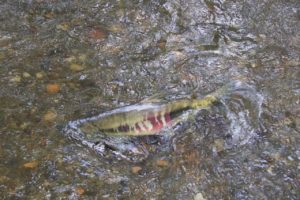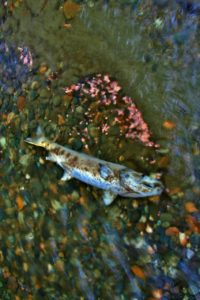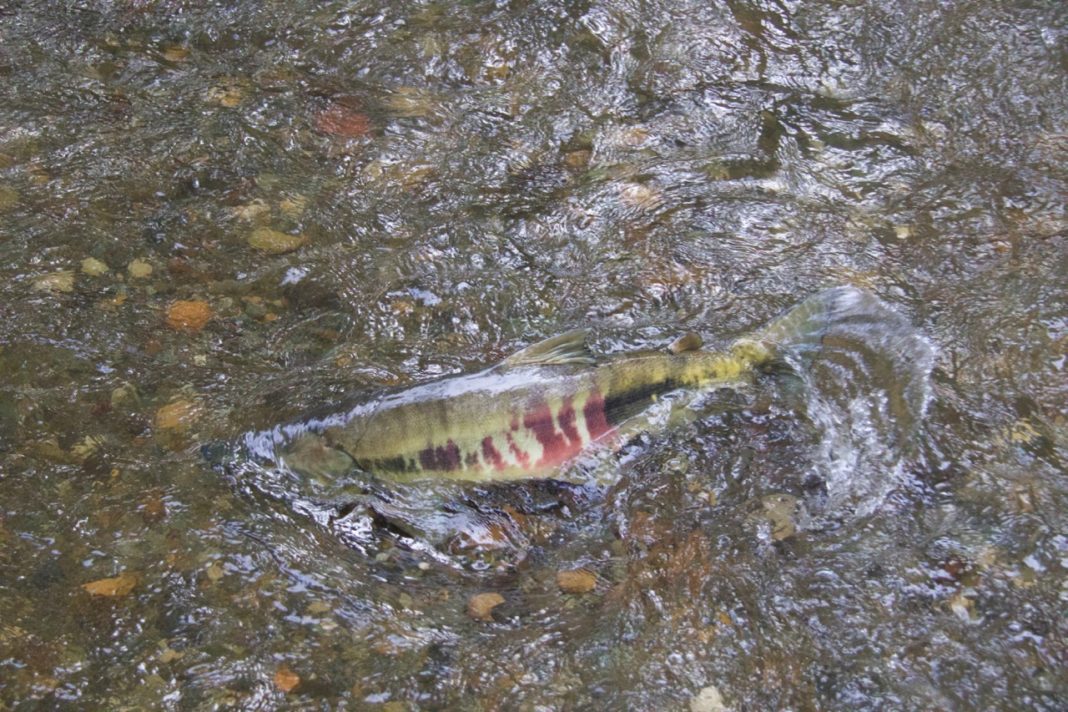Just a few miles from the pavement and cars of downtown Olympia, hidden in an enclave of newly reclaimed forest, sits McLane Creek Nature Trail. Seemingly unaware of the rest of the world, this small section of land acts as the perfect microcosm of the Pacific Northwest. Full of water, moss, towering trees and home to beavers, migratory species of birds and endless newts, this small park in Thurston County has one more amazing feature. Each year, as fall starts to wind down and the rains flood every creek, gully and river, the titular creek becomes full with more than water.
 Salmon, hundreds of them jumping and slapping their way upstream to their spawning grounds, call McLane Creek their place of birth and death. Showcasing the circle of salmon life, each fall marks their spawning season and each spring sees the fry, the baby salmon, start swimming downstream toward the southernmost point of Puget Sound. McLane Creek is home to one of the most incredible displays of the salmon life cycle anywhere in the Pacific Northwest and you need to experience it this year.
Salmon, hundreds of them jumping and slapping their way upstream to their spawning grounds, call McLane Creek their place of birth and death. Showcasing the circle of salmon life, each fall marks their spawning season and each spring sees the fry, the baby salmon, start swimming downstream toward the southernmost point of Puget Sound. McLane Creek is home to one of the most incredible displays of the salmon life cycle anywhere in the Pacific Northwest and you need to experience it this year.

Starting in November and going through December, the salmon spawning and dying season makes McLane Creek a hotbed of action. In late October, as most of Thurston County forgets about the inundation of salmon that occurs on our regions rivers and streams, McLane Creek becomes nearly “stuffed to the gills” with chum salmon returning home. Splashing and jumping over logs, the spawning season is short and sweet, visible from numerous lookouts along the creek.
There are three ideal areas to watch the salmon spawn, located at the viewing stations along the back trail. The southern-most viewpoint has the best boardwalk and platform to see the salmon, as well as a ton of information from the local group Stream Team, who even put up wooden salmon along the trail to lead you to their area. This is an awesome place to get to know the life cycle and facts about the salmon and even have a chance to talk to an expert when they are present.

This area is great, but the actual salmon viewing isn’t the best. Instead, head north (downstream) along the trail to the next creek access point. Here, the infrastructure is comparatively lacking, but the salmon viewing is much better. Right up close to the water, the thrashing salmon will occasionally splash onlookers as they struggle against the current to move upstream. This area also gives you a better view of the bottom of the creek, giving glimpses of salmon eggs sitting on the creek-bed in the slow moving water areas. Seeing salmon eggs wiggling in the current gives a better appreciation for the struggles a salmon has from the minute the egg becomes fertilized. In three to five years, if they survive birth, swimming downstream and then then living in the ocean, they will battle their way past nets and fisherman to return to this small stream where you are standing.
The third and final place to watch salmon is along the bridge found further downstream. Here, you get a bird’s eye view of the salmon making their way up the creek, as well as a chance to stand along the banks and get a close-up view. This is also a great place to go if the rain is heavy because you can stand in relative dryness under the bridge. Standing on the bridge or along along the banks of the creek, when the water is low, gets you more views of salmon eggs and the slowly swimming, dying salmon.

When December rolls around, the salmon experience isn’t as pleasant. Walking along the trail, the air becomes pungent the closer you get to the creek. Your nostrils won’t be happy, but the experience of seeing hundreds of dead and rotting salmon along the riverbanks is an important one. This is the last good deed by the returned and spawned out salmon. As they rot and smell up the forest, their remains help fertilize the plants along the river and even provide nutrition to the plants that their offspring will be eating in the spring. I recommend hiking to each of the three viewpoints. Yes, it will smell pretty bad, but this is the life cycle of the salmon and yet another incredibly rare sight along this small, often overlooked creek. Remember to avoid walking on the gravel bars when the water level is down; this is where the salmon eggs are buried.

Once spring rains roll around, the salmon will hatch and the small fry will start life along this waterway. Draining into the southernmost point of the Puget Sound, the McLane Creek chum head into the salty waters, hoping they too will return home. The salmon watching experience at McLane is amazing. This year, head to McLane Creek Nature Trail in November, return in early December and follow up in the spring to witness and be a part of this unique Thurston County wildlife extravaganza.
Thrifty Thurston highlights inexpensive family fun in Thurston County. The weekly series focuses on family-friendly activities throughout our community. If you have a suggestion for a post, send us a note at submit@thurstontalk.com. For more events and to learn what’s happening in Olympia, Lacey, Tumwater and the surrounding area, visit our complete events calendar.




















































